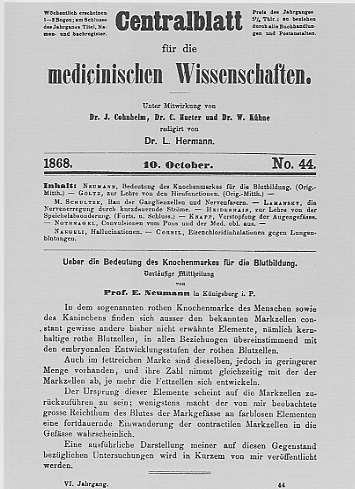|
|
|
|
||||||||||||||||||||
|
Translation In the so-called red bone marrow of man as well as the rabbit, one can regulary find, in addition to the well known marrow cell, certain other elements which have not been mentioned until now; namely nucleated red blood cells, in every respect corresponding to embryonic stages of the red blood cells. Also is the marrow rich in fat, the same cells are present but in lower quantity and their number decreases parallel to the decrease in the number of marrow cells and the increase in the number of fat cells. It is possible, to trace the origin of these elements in the blood of the marrow cells The high content of colorless elements in the blood of the marrow makes it likely that these is a migration of contractile marrow cells into the vessels. A thourough description of my obersations will be published. (10. Oct. 1868) (It was published in 1969, see literature) |
|
In 1866 Ernst Neumann was appointed professor of pathology and head of the nearly new institute of pathology at Königsberg (founded in 1865 by R. von Recklinhausen, pupil of R. Virchow). In a preliminary communication (Centralblatt für die medizinischen Wissenschaften, Oct. 10th, 1868), and subsequent papers, Ernst.Neumann described the presence of nucleated red blood cells in bone marrow sap of humans and rabbits obtained by squeezing bones. On the basis of this observation, he was the first to conclude that during postembryonic life, erythropoiesis is taking place in the bone marrow. ... Former studies by Neumann pointed to the fact that leukocytes are also formed in the bone marrow. Anticipating the essence of our present day cognitions, Neumann postulated a common stem cell for all hematopoietic cells (see button hematology and stem_cell). Other medical discoveries that carry the name of Ernst Neumann see www.gelehrtenfamilie-koenigsberg.de/Zahnheilkunde.html “Fibroblasten” und “Fibrinoide Degeneration und Nekrose” www.gelehrtenfamilie-koenigsberg.de/Der_Pathologe_u._Haematologe.html Hämosiderin” Neumanns“ Charcot-Neumann´sche Kristalle” “Muskelknospen” Neumanns“ “Neumann´ Tumor”: kongenitale Epulis “Nervenentwicklungsgesetz” Neumanns In 2003 a dissertation from the “Medizinhistorischen Institut in Hannover” was published. Carsten Buzmann asked for Neumanns work in regard to the regeneration and degeneration of nervs and muscles. Literature: Buzmann, C.: Der Pathologe Ernst Neumann und seine Forschung auf dem Gebiet der Degeneration und Regeneration periferer Nerven nach Kontinuitätstrennung. Dissertation Medizinische Hochschule Hannover, August 2003.
|
| [welcome] [Ernst Neumann] [Pathology] [Hematology] [stem cell] [Cytology] [Award] [Literature] [Archive] [celebrations] [Rediscovery] |
